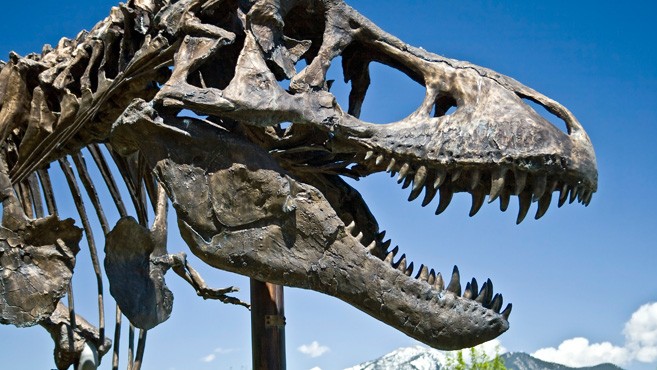|
|
|
|
It’s been 65 million years since the last of the dinosaurs roamed the earth, yet this April the Wankel T. rex, a Tyrannosaurus rex from Bozeman, Montana, made an incredible cross-country journey. In fact, it traveled 2,300 miles in just 48 hours, and along the way picked up another nickname: “the Nation’s T. rex.?
An amazing discovery
The Nation’s T. rex was discovered in 1988 by Kathy Wankel at a Montana wildlife refuge. Nearly 85 percent complete, it is one of the most intact skeletons of its kind ever found. Especially exciting for scientists: The nearly complete skull may provide new insights into how it lived — and how it ate.
For years, this remarkable specimen had been housed in the Museum of the Rockies, displayed in its “death pose,” a recreation of how it was discovered in the ground. Now it’s ready for the big leagues: The T. rex is on loan to Smithsonian’s National Museum of Natural History for the next 50 years.
But first it needed to get there. At 7 tons, it couldn’t exactly take the red-eye.
A special delivery
The museum’s staff needed a way to securely transport this priceless cargo while maintaining a carefully regulated atmosphere and seamless security.
That’s where FedEx came in.
The FedEx Custom Critical team often ships rare and unusual items — everything from other dinosaur fossils to part of the Titanic’s hull — and handling these shipments with special care and unique considerations is second nature to them. They were more than prepared.
The bones were wrapped in custom-made plaster cradles and then packed into 16 foam-filled boxes, which were sealed with special tape. The main crate was equipped with SenseAwareSM powered by FedEx, a device that monitors conditions in real time, providing 24/7 access to information like location, humidity, interior temperature, barometric pressure, shock and light exposure.
This state-of-the-art sensor-based logistics system is invaluable for shipping sensitive items like vaccines, medical samples, artwork, pharmaceuticals, aerospace parts — and, as it turns out, dinosaurs.
Thanks to this technology, sensors were on constant alert so that conditions could be immediately adjusted — if, for example, the crates got hotter or colder than the Smithsonian’s recommended room temperature. Geo-fencing allowed the team to track each package’s location. And light detection meant any would-be thieves would have been discovered the moment the lid was lifted.
The crates were loaded onto a specially equipped 18-wheeler. Temperature probes throughout the cargo box provided real-time temperature history during transit. The Qualcomm in-cab two-way communications and status-tracking system enabled online tracking of the shipment’s location at every point along the way. The vehicle was also equipped with emergency alert capabilities and cargo lock-and-seal services.
Over the next two days a husband-and-wife duo drove the precious cargo from Bozeman to Washington, D.C., with a two-person security team escorting them in a chaser vehicle the entire way.
A happy ending
The Nation’s T. rex arrived safe and sound on April 15, and the bones will be displayed in the Smithsonian’s “Rex Room” until October. It will then travel to Canada, where a company will design and create custom support structures to mount the bones into a lifelike position. By fall 2019, the Nation’s T. rex will be back in the States in time to be the star attraction of the Smithsonian’s brand-new dinosaur hall.
For the first time in over 65 million years, the Nation’s T. rex will stand tall — with help from scientists, museum officials and FedEx.
Got critical cargo?
Even if you aren’t shipping a 7-ton dinosaur fossil, FedEx Custom Critical has innovative air and ground solutions — and SenseAware — to keep your high-value, temperature-sensitive items secure and on schedule.
